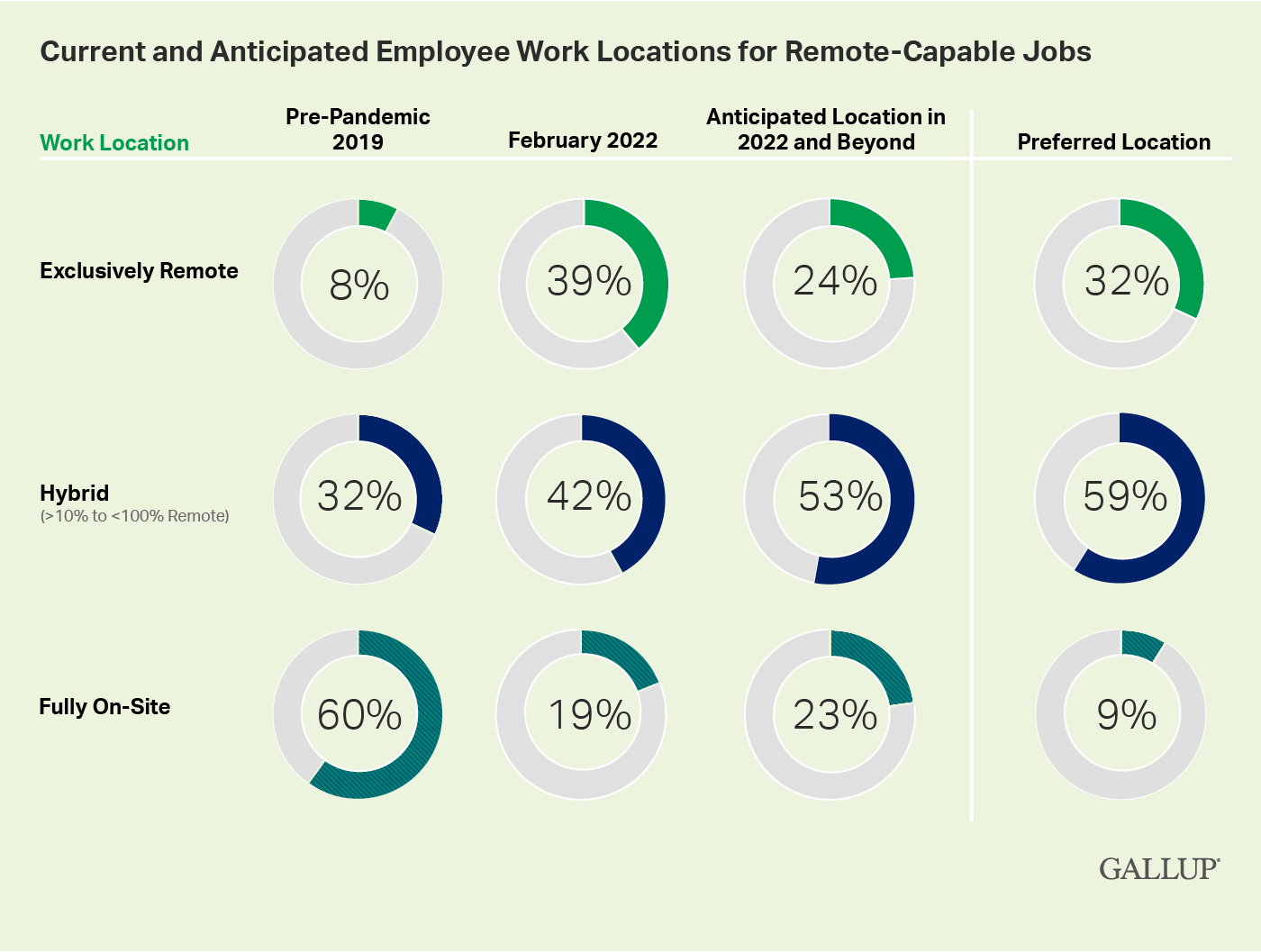Businesses and their employees are increasingly embracing the hybrid working model. The pandemic forced companies to find new ways of working to survive. It’s proved to be beneficial for productivity and employee morale. But it’s not without its challenges, so let’s explore them and discover how to overcome them.
Defining hybrid work
Before we look at what businesses must consider with hybrid working, we should know what it means. Fully remote workers can do their job from anywhere, usually from home. Many workers still go to an office daily. Hybrid workers will split their time between the office and working remotely.

Image sourced from gallup.com
Where possible, hybrid working has become mainstream. It’s a growing trend. Companies are facilitating hybrid working as demand amongst employees increases. It comes with a range of benefits for both employers and employees, including:
- Increased productivity
- Improved cost efficiency
- Work/life balance
- New ways to collaborate
- Environmental benefits from reduced commuting
But businesses should be aware that there are also potential pitfalls. Modern tools like virtual call center software can help businesses cut costs, improve productivity, and attract and retain top talent. This is only made possible so long as it’s implemented correctly. So let’s now look at possible problems that can arise, and how to solve them.
Collaboration
Hybrid working demands that team members can collaborate via on-premise or cloud technology. Employees should be confident in making calls from a browser and using video conferencing tools in tandem with face-to-face interaction.
On top of this, they should be confident in using any collaborative solutions you integrate into their workflow, whether you use an outbound call center platform, project management tools, or cloud-based sales software.
Companies thrive when their talent can collaborate effectively. An advantage of the office is the ability to simply walk across the room to get an answer to a burning question. That isn’t always possible with the hybrid work model. If half the team is in the office and the rest are at home, then there needs to be systems in place to account for that.
This requires businesses to invest in seamless communications tools, collaboration software, and training.
Motivation
Traditional office environments provide many avenues for motivating team members. It’s easier to organize fun activities, hand out recognition awards, or celebrate success with the whole team.
With a hybrid work model, team members may have a flexible work schedule and can be split between home and office working. So businesses should find ways to engage equally with all employees.
Happily, technology allows for engagement to take place wherever you are. Regular team video or call conferences allow managers to deliver the company’s messages. They should regularly restate the company’s goals and define the employee’s role in achieving them.
Individual check-ins play a huge part in motivating employees. Thus, managers should engage with their teams regularly.
Teams will benefit from getting together in person from time to time. It serves as a reminder that employees are part of a team working toward the same goals. Also, it reinforces bonds between team members and between employees and management.
A good tip for managing hybrid teams is to organize occasional in-person get-togethers. A fun day out will benefit engagement, motivation, and wellbeing.
Wellbeing

We all sometimes experience stress or other mental health issues. Team members often have struggles at home that will affect their work performance. Remote work can often contribute to a sense of isolation and blur the lines between work and home life.
Some team members can feel pressured to work in unhealthy ways. This is because of a system that is, ironically, meant to provide flexibility.
Businesses have a duty of care for their employees. Managers in office environments are more able to pick up on potential mental health issues. This is because they’re interacting with their teams daily and in person. That can be more difficult with a hybrid model.
Managers should ensure that employees don’t feel undue pressure. When conducting check-ins, managers should take the time to ask how employees are doing. They should discuss whether there are any struggles the team member is experiencing and find out if the business can assist in any way. Technology can help here.
Organizing the team

Hybrid working offers many advantages in terms of flexibility and office costs. It also throws up challenges around those subjects. Some roles require employees to work regular hours, whereas others don’t. Office space can be reduced, but what if there are days when there aren’t enough workstations available?
In regards to working hours, frank conversations need to take place with team members about how far flexibility can go. It will often depend on the job role, but setting schedules across a workforce is best.
The advantage of the hybrid model is that it doesn’t have to be nine-to-five. A good workflow orchestrator will help managers to schedule workers appropriately. Team members gain clarity of expectations and vital tasks are completed.
When it comes to office space, businesses will do well to set up a rota. This will prevent instances of workspace overcrowding. There may be times when a certain project requires more office space. Companies can empower team members to organize office use themselves through a booking system.
Businesses should encourage activities to be done remotely when there’s no benefit to doing them in the office. A modern hybrid work solution can give your team all the communication and collaboration tools they need.
Maintaining a good work culture
When team members are working remotely, they can feel separated from the company. This impacts motivation and well-being. Disunity is bad for business. Companies risk diluting their core values when transitioning to a hybrid work model.
Businesses must reevaluate the culture they’re trying to foster. This doesn’t mean abandoning their values altogether, but adapting them to the new normal. It’s an opportunity for the whole company, from senior managers down, to come together. As a company, they will find new ways to collaborate and achieve their shared goals.
We’ve already discussed the benefits of in-person events. Businesses must use such events to reinforce company culture. They must also boost engagement more widely. This will help employees understand their role in the business’s success.
Security
The rise in hybrid working — and with it, the increasing use of virtual systems like time trackers, call center inbound software, and remote access technology — has cybersecurity implications. Team members are coming and going with work products. Remote workers are logging into shared systems from anywhere in the world.
This presents a risk to customer data and the company IP. There’s no getting around the use of cloud-based technologies if companies wish to embrace hybrid working. Indeed, it’s what makes such arrangements practical in the first place.
Companies must implement robust security measures and follow data quality best practices. Systems should be regularly monitored for threats, and software needs to be kept up to date. Implementing a bring your own device policy can reduce demand for workstations. It can also provide cost benefits.
However, it also presents an additional security risk. Therefore, employees must also keep their own security software updated. This applies to those working from home too.
Leadership
Managers tend to be experienced and valued members of any team. Adjusting to hybrid working may be especially challenging for them. Those who can micromanage employees in the office environment will struggle to do so when operating in a hybrid model. It doesn’t lend itself well to that kind of management.
Businesses need to instill their adjusted working culture in their managers. They should be encouraged toward transparency and effective communication in enterprises. Companies should discourage micromanaging and instead encourage focusing on the bigger picture. This allows managers to more effectively get their teams to deliver.
Unconscious bias
While we’re on the subject of leadership, we need to talk about unconscious bias. This is where leadership can favor those they see face-to-face in the office over those that work remotely. It’s referred to as “unconscious” because it doesn’t stem from malign intent; it’s not deliberate. Humans are naturally social creatures and form bonds with those we see on a regular basis.
If team members pick up on a disparity in the treatment they receive, they’ll be discouraged. This risks the success of the hybrid model and may lead to an exodus of talent.
A conscious effort needs to be made to avoid this bias. Leadership must endeavor to treat all workers equally. Managers should be encouraged to judge team members by the work they produce and their contribution to the company’s goals.
Hybrid working: the new normal

Hybrid working can help businesses reduce costs, increase efficiency, and improve employee morale. It’s good for the environment, too, thanks to reduced commuter traffic. As fuel and energy costs continue to rise, both businesses and employees can benefit. It strikes the right balance between traditional office working and remote working.
It’s clear, though, that there are potential risks. Businesses that plan effectively stand to make hybrid working a success. Thanks to technological progress, it’s easier than ever to implement. Businesses must ensure they take a human-centric approach, despite their reliance on tech.
The hybrid working model is here to stay. There’s little point in resisting. It’s become the new normal.

